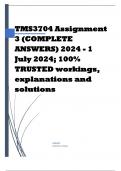TMS3704 Assignment
3 (COMPLETE
ANSWERS) 2024 - 1
July 2024; 100%
TRUSTED workings,
explanations and
solutions
ADMIN
[COMPANY NAME]
,1. Discuss in detail learner-centred approaches to teaching. 1.1 Use
practical tools and approaches to enhance your discussion. 1.2
Relate your examples to the teaching of any topic in Business
Studies (Grade 10 only).
Learner-Centred Approaches to Teaching
Learner-centred approaches to teaching prioritize the needs,
abilities, interests, and learning styles of students. This pedagogical
approach encourages active participation, critical thinking, and real-
world application of knowledge, moving away from traditional
teacher-centred methods. It fosters a more engaging and interactive
classroom environment, where students are at the heart of the
learning process.
Key Characteristics of Learner-Centred Approaches
1. Active Learning: Students actively engage with the material,
participate in discussions, and collaborate with peers.
2. Collaborative Learning: Emphasis on group work and peer-
to-peer learning.
3. Personalized Learning: Tailoring instruction to meet the
individual needs and learning styles of students.
4. Reflective Learning: Encouraging students to reflect on their
learning experiences and outcomes.
Practical Tools and Approaches to Enhance Learner-Centred
Teaching
1. Interactive Learning
2. Technology Integration
3. Project-Based Learning
, Interactive Learning
Case Studies
• Definition: A case study is an in-depth investigation of a real-
world business scenario. It allows students to apply theoretical
concepts to practical situations.
• Example in Business Studies: Analyzing a local small
business's marketing strategy. Students can identify strengths
and weaknesses, suggest improvements, and present their
findings.
Activity: Students are divided into groups, each assigned a
different local business. They conduct research, interview the
owners, and analyze the business's marketing approach. Each
group presents their findings and recommendations to the
class.
Role-Playing
• Definition: Role-playing involves students assuming roles in
simulated business scenarios, helping them understand
different perspectives and develop problem-solving skills.
• Example in Business Studies: Simulating a negotiation
between a supplier and a retailer.
Activity: Students are assigned roles (e.g., supplier, retailer,
mediator) and given a scenario where they must negotiate
terms such as pricing, delivery schedules, and payment terms.
After the role-play, the class discusses the negotiation process
and outcomes.
Technology Integration
Online Simulations




